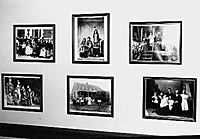- Benedicte Wrensted ›
- How Images are Influenced
How Images are Influenced
The Subject's Influence
Edward Edmo, Sr., believes that his uncle Jack Edmo's fondness for having his photograph taken and for presenting his family at public gatherings was unique and not shared by Jack's other brothers. Edward's father, Tom Edmo, in particular was too occupied as chief of the Fort Hall Reservation police force and "too serious" to be concerned with being photographed.
To his nephew, the photo of Jack Edmo and his family represents a fun-loving "sporting" person, a man with an extroverted personality, an atypically social member of a large and active family. Yet the same image has been perceived by Anglo viewers as a generic portrait of a "typical" Indian family.
In the Jack Edmo family photos we also see the subject's control of the imagery. This included the frequency with which photographs were taken and the selection of clothing worn.
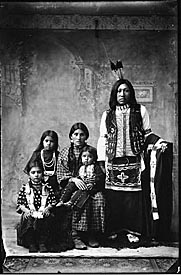
Photograph taken 1897-1898. Seated, left: Helen Edmo; standing, left: Bessie Edmo; seated, center: Lizzie Randall Edmo (b. 1869 d. 1968) holding Eugene Edmo; standing, right: Jack Edmo.
Credit: * National Archives and Records Administration, Still Picture Branch: 75-SEI-93.
This photo is one of the most popular images of the Edmo family. It was used by the National Archives and Records Adminstration (NARA) in Washington D.C. in its 1979 exhibit and exhibit catalog entitled, "The American Image: Photographs from the Archives of the United States, 1860-1960." In the 1990s the photo was displayed on the wall at the NARA in an area where all researchers must be processed to have access to the building. (Below right)
Jack is wearing moccasins with American Flag beaded design; breechcloth and vest with cut-glass beads and metal rivets, which he may have designed himself; quilled armbands; and traditional hairpipe and breastplate choker. Lizzie's and Bessie's dresses are cloth in a traditional cut. Helen's velveteen dress is decorated with cowrie shells, and she wears a women's style hairpipe necklace.
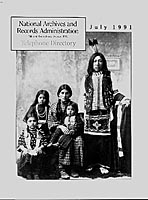
Credit: Scherer Personal Collection.
We cannot know the extent to which the glass plates and photographs that remain are representative of Wrensted's work or have been selected and filtered by Anglos. That the majority of images emphasize Indian elements of clothing - blankets, beadwork, feathers - leads us to suspect the influence of the Plains Indian stereotype, which had become established by the turn of the 20th century.
Wrensted's work also portrays some Shoshone-Bannock wearing non-stereotypical clothes. Her photographs include men in cowboy outfits and the three-piece suits of prominent ranchers, and women in cotton dresses.
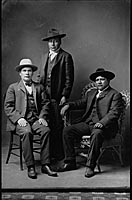
Credit: * National Archives and Records Administration, Still Picture Branch: 75-SEI-35.
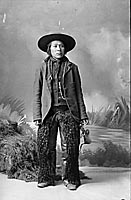
Credit: * National Archives and Records Administration, Still Picture Branch: 75-SEI-108.
The Viewer's Influence
Misinterpretation of the photo by the viewer occurs because of a lack of information and context. Without knowledge of its subject, a photograph can perpetuate stereotypes.
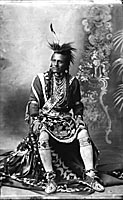
Logan Appenay, a Bannock (b. 1858 d. 1922) in Grass Dance clothing, including: anklets with bells, a loom-beaded bandolier, and a Great Lakes floral design breechcloth. He is also wearing beaded moccasins with flaps and designs influenced by Cree or Metis styles, loom-beaded garters, a sash of bugle beads over the right shoulder and a cloth shirt with floral designs on the cuffs and yoke. A Grass Dance bustle is visible behind him. The dirt smudges on is right leg suggest that he wore this costume before this picture was taken.
This photo with its floral backdrop, classical pose, heavily beaded costume, hair roach and feather, and use of blanket, creates an image full of contrasts and tensions that have given it much popularity. Reproduced by the NARA in Washington, DC as a part of a 1979 exhibition, it appeared on the cover of the exhibit catalog.
Credit: * National Archives and Records Administration, Still Picture Branch: 75-SEI-59.
In each case, the image was not presented as the portrait of a specific Indian dressed for a known occasion, but as an icon of the "noble savage," a frequent representation in popular advertising. (see photos above and below) It was reproduced in these examples without indication of the photographer, tribe or individual - all of which are identified for the first time in this project.
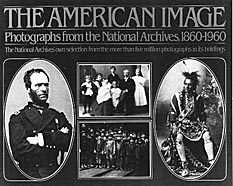
Credit: Scherer Personal Collection.
It was also made into a large mural for an archival conservation exhibit outside the Archive's main reading room, where it was on display thorughout much of the 1990s. (Below Right)
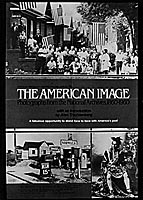
Cover of The American Image: Photographs from the National Archives 1860-1960. With an introduction by Alan Trachtenberg. History Book Club, February 1980.
Credit: Scherer Personal Collection.
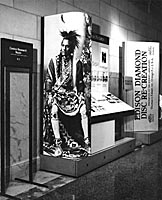
Credit: Photo by Victor Krantz, 1993, Scherer Personal Collection.
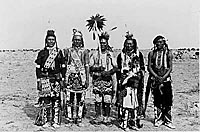
Grass Dancers about 1900, by an unknown photographer. Left to right: Charlie Pizoka, Logan Appenay, an unidentified man holding a feathered staff, Jack Edmo and one of his sons, and an unidentified young man.
Credit: Idaho State Historical Society, Boise: 77-69.7
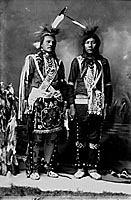
Credit: * National Archives and Records Administration, Still Picture Branch: 75-SEI-81.
The Photographer's Influence
When photographing Native Americans, the photographer sometimes added items to signal the subject's Indianness, such as pipe bags or blankets. Wrensted was not the only photographer to use the blanket as an Indian studio prop. In nineteenth-century terminology, "blanket Indian" meant an Indian with traditional values who refused to assimilate.
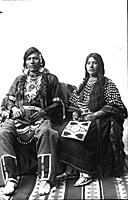
Credit: Smithsonian Institution, National Anthropological Archives, Eugene O. Leonard Collection, Photo Lot 92-3.
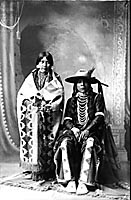
Credit: * National Archives and Records Administration, Still Picture Branch: 75-SEI-122.
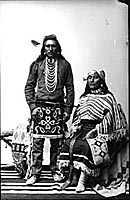
Unidentified man and woman.
The man's breechcloth and the pipe bag next to him appear on the other individuals in the Wrensted photos. These may be shared items rather than studio props. A blanket identical to the one on which the woman is seated was donated to the Idaho Museum of Natural History (IMNH), by Helen Wrensted Sherwood, Benedicte's niece, in 1990.
Credit: * National Archives and Records Administration, Still Picture Branch: 75-SEI-139.
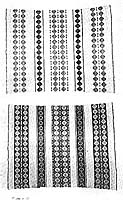
Credit: (Merkley, 1994).
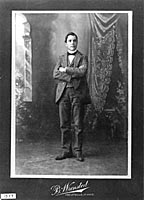
Credit: Smithsonian Institution, National Anthropological Archives, Eugene O. Leonard Collection, Photo Lot 92-3.
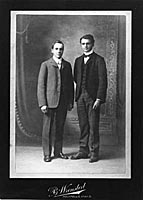
Eugene O. Leonard and Willis Reeves, taken in 1902.
Willis' too-long trousers and too-short coat sleeves are indicators of his less affluent status. Willis went to Weiser Academy, Weiser, Idaho, with Eugene O. Leonard in 1899 and 1900. Eugene and Willis were close friends. A September 19, 1902 letter from Mrs. Leonard Derr to E. O. Leonard says: "I have the pictures of Willis and yourself. Will send you one of each. You can send yours taken alone to Ralph if you wish." The photo used here is likely this image. When Wrensted photographed these Euro-American friends, she left out the blankets, the Indian "signifier."
Credit: Smithsonian Institution, National Anthropological Archives, Eugene O. Leonard Collection, Photo Lot 92-3.
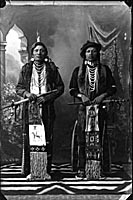
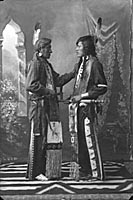
(left) Credit – National Archives and Records Administration, Still Picture Branch: 75-SEI-105. (right) Idaho Museum of Natural History: 253226.
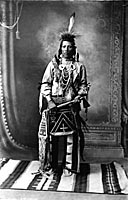
Credit: * National Archives and Records Administration, Still Picture Branch: 75-SEI-134.
[ TOP ]
